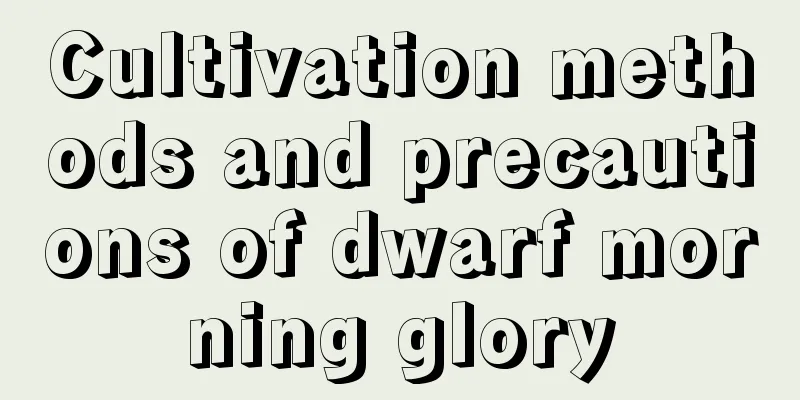Cultivation methods and precautions of dwarf morning glory

|
Dwarf petunias are highly adaptable but are sensitive to standing water. Therefore, when caring for potted plants at home, the humidity of the soil needs to be adjusted artificially. This means replenishing soil moisture while also ensuring that excess water is removed promptly. Let’s learn about the cultivation methods and precautions of dwarf morning glory. 1. Pot soil selection Petunia is suitable for planting in larger pots with a diameter of about 20-30 cm to ensure good air permeability, and avoid using pots with poor air permeability. The soil should be nutrient-rich sandy loam, and the bottom can be padded with plastic foam or gravel to enhance drainage. 2. Lighting requirements Petunias need plenty of sunlight to promote growth and nutrient synthesis. In spring, autumn and winter, make sure the plant has access to sufficient sunlight and place it on a sunny balcony or outdoors. In summer, you need to pay attention to shading to prevent strong sunlight from damaging the leaves and flowers. 3. Temperature management The ideal growing temperature for petunias is 15-25 degrees Celsius. During cold winters, the plants should be moved indoors to help them overwinter safely. 4. Fertilization strategy Petunia has a higher demand for fertilizer , so base fertilizer needs to be added when planting. During the growing period, fertilizer should be applied once every half a month to support its growth. 5. Notes The seedling stage of petunia is longer and the true leaves grow slowly. During the germination period, the temperature should be kept at around 20℃, the soil should be kept moist and loose, and sufficient sunlight should be ensured. Petunia seedlings have weak root systems and limited ability to absorb water. The soil should be kept moist and avoid waiting until the soil is completely dry before watering; at the same time, sufficient light should be ensured, but avoid direct sunlight. If petunias are iron deficient, the leaves may turn yellow. Iron can be supplemented by watering with ferrous sulfate solution. In addition, since peat soil substrate is prone to lack of iron, thin fertilizer should be applied regularly to supplement trace elements. The above are the cultivation methods and precautions for dwarf morning glory. In the past, many friends did not take morning glory seriously, but now they can appreciate its beauty.
|
>>: What fertilizer to use for roses? What to do if you use too much fertilizer?
Recommend
How to grow succulent pine
1. Lighting Like other succulents, the succulent ...
Bonsai production and maintenance of Euonymus
Production and maintenance of Euonymus bonsai Pro...
Water and fertilizer management methods for red peony
Growth habit If you want to grow the red peony we...
Can Tillandsia be hydroponically cultivated?
Can Tillandsia be hydroponically cultivated? Till...
How to water and fertilize Mimosa
How to water mimosa Mimosa is a tropical plant th...
How to remedy the yellowing of leaves of lucky bamboo grown in water?
Hydroponic lucky bamboo is popular for its fresh ...
The difference between spider silk, hairy silk and red silk
The difference between spider silk and hairy silk...
What fertilizer to use for the fortune tree
The trunk of the money tree is thick and simple t...
The efficacy and function of castor
1. Laxative Castor oil can relieve symptoms such ...
When to water succulents
1. When to water When watering succulents, wait u...
When is the best time to plant Swiss chard?
Swiss chard is a common vegetable, also called th...
How to grow pine trees
Pine Growing Conditions Pine trees mostly grow in...
Spider Orchid cultivation methods and precautions
1. Maintenance methods 1. Substrate selection: Th...
How long do spinach seeds need to be soaked before planting?
When growing spinach , proper seed preparation is...
What to do if the cactus withers
Rescue methods Repotting There are two points abo...









